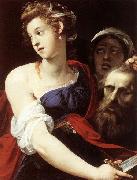La Peinture à l'huile en gros de Chine & Encadre |
|||||||||||

|
|||||||||||
|
|
|
||||||||||||||
|
GIuseppe Cesari Called Cavaliere arpino
Rome 1568-1640 |
||||||||||||||
|
|
||||||||||||||
|
||||||||||||||
|
|
||||||||||||||
| GIuseppe Cesari Called Cavaliere arpino
Rome 1568-1640 Judith_with_the_Head_of_Holofernes 61,3 x 48 cm Berkeley Art Museum, University of California Cavaliere d'Arpino's (Giulio Cesari's) Judith with the Head of Holofernes symbolically alludes to the violent decapitation of the Assyrian general without showing the gruesome moment that both Caravaggio and Artemisia Gentileschi chose to depict. Instead a beautiful, almost demure, Judith raises Holofernes' head by his locks as her maidservant Abra looks on in puzzled reverence. Cavaliere d'Arpino's Judith is the embodiment of female virtue and moral perfection, an ideal heroine who has redeemed her people. Yet, at the same time, she seems capable of exercising her seductive powers directly upon the viewer, as if the beholder were Holofernes. She is in possession of two dangerous weapons, her sword and her sexual allure. In 1602-03 Cavaliere d'Arpino had frescoed a series of Old Testament heroines in the Villa Aldobrandini at Frascati. There he depicted Judith as a full-length figure striding across the plain in front of the enemy encampment while Abra follows behind stuffing Holofernes' head into a sack. Topologically the figures are very similar, but in the easel painting Cavaliere d'Arpino condensed the composition so that the picture essentially becomes an idealised 'portrait' of Judith. In this sense it is very close to his Diana (Pinacoteca Capitolina, Rome), in which the huntress is also reduced to a half-length idealised figure. In both these 'portraits' there is an emphasis on the decorative effects of colour and design. The brilliant reds, blues and whites of Judith's costume serve as a foil for the carefully delineated jewels and golden sword hilt. Baglione emphasised that Cavaliere d'Arpino was capable of working in two different styles, one of which was far more superficial than the other. It is likely that the more 61,3 x 48 cm Berkeley Art Museum, University of California Cavaliere d'Arpino's (Giulio Cesari's) Judith with the Head of Holofernes symbolically alludes to the violent decapitation of the Assyrian general without showing the gruesome moment that both Caravaggio and Artemisia Gentileschi chose to depict. Instead a beautiful, almost demure, Judith raises Holofernes' head by his locks as her maidservant Abra looks on in puzzled reverence. Cavaliere d'Arpino's Judith is the embodiment of female virtue and moral perfection, an ideal heroine who has redeemed her people. Yet, at the same time, she seems capable of exercising her seductive powers directly upon the viewer, as if the beholder were Holofernes. She is in possession of two dangerous weapons, her sword and her sexual allure. In 1602-03 Cavaliere d'Arpino had frescoed a series of Old Testament heroines in the Villa Aldobrandini at Frascati. There he depicted Judith as a full-length figure striding across the plain in front of the enemy encampment while Abra follows behind stuffing Holofernes' head into a sack. Topologically the figures are very similar, but in the easel painting Cavaliere d'Arpino condensed the composition so that the picture essentially becomes an idealised 'portrait' of Judith. In this sense it is very close to his Diana (Pinacoteca Capitolina, Rome), in which the huntress is also reduced to a half-length idealised figure. In both these 'portraits' there is an emphasis on the decorative effects of colour and design. The brilliant reds, blues and whites of Judith's costume serve as a foil for the carefully delineated jewels and golden sword hilt. Baglione emphasised that Cavaliere d'Arpino was capable of working in two different styles, one of which was far more superficial than the other. It is likely that the more |
||||||||||||||
|
Related Paintings to GIuseppe Cesari Called Cavaliere arpino :. |
||||||||||||||
|
|
||||||||||||||
|
|
||||||||||||||
|
CONTACTER DES Etats-Unis |







